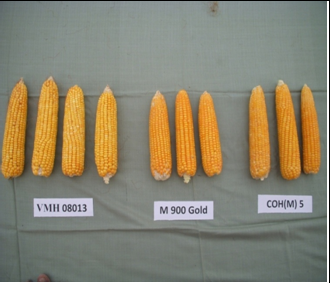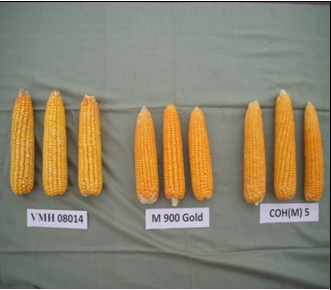Maize Research Station, Vagarai

The station has been inaugurated during December 2008 and the activities are being initiated
Mandate:
1. Evolving new high yielding hybrids suitable for irrigated and rainfed conditions.
2. Identification of suitable management practices for increasing maize production and productivity in TamilNadu.
3. Characterization of maize utilization and maize based industries through various research programmes
4. Production of quality hybrid seeds and supply to the farmers at lower price.
5. Imparting hybrid seed production training to the farmers.
Activities:
1. Collection and maintenance of maize germ plasm.
2. Development of single cross hybrids suitable for irrigated and rainfed ecosystem.
3. Evaluation of hybrids under AICRP on maize.
4. Development of specialty corn hybrids viz., sweet corn, baby corn, pop corn and Quality Protein Maize.
5. Standardization of seed production technologies for hybrids.
6. Imparting training to the farmers on maize hybrid seed production.
7. Development of package of practices for new hybrids of maize.
8. Evaluation of conventional maize hybrids sponsored by sponsored by M/S Monsanto India Limited, Mumbai
9. Front Line Demonstration of suitable technologies in maize financed by ICAR-DMR, New Delhi
10. Exploring source sink relationship of maize to maximize productivity.
11. Nutrient and moisture dynamics on maize based cropping system under sub surface fertigation.
12.Composting technology for maize stubbles.
13. Permanent manurial experiment for maize based cropping system.
14. Developing nutrient management strategies for Iron and Zinc deficiencies in maize.
15. Identification of resistant donor for major like downy mildew, banded leaf sheath blight, turcicum leaf blight and rust.
16. Formulating a viable insect management strategy for maize integrating ecofriendly and low cost technologies.
17. Screening of inbreds for stem borer resistance.
Achievements:
- Crop Improvement
Single cross hybrid evaluation suitable for irrigated condition.
New single cross hybrids numbering 141 were synthesized and evaluated along with the checks COH (M) 5 (TNAU Check), M 900 Gold and Hishell (Private check). On the biometrical observations seven hybrids viz., VMH 08001, 08002,08013,08014,08015, 08016 and 08020 are found to be promising. Among them four single cross hybrids viz., VMH 08013 (8789 kg ha-1, 107 days) VMH 08014 (8539 kg ha-1 108 days) , VMH 08001 (8204 kg ha-1, 105 days) and VMH 08015 (8128 kg ha-1, 110 days) were found to be superior to the private check 900m Gold (8019 kg ha-1 108 days) in the station trials . Among the four VMH 08013 and VMH 08014 were nominated for MLT during Kharif and Rabi’10.
Breeding for drought tolerant single cross maize hybrids suitable for rainfed ecosystems
Evaluation of maize inbreds for drought tolerance
A total of 33 and 28 inbreds were found to be drought tolerant in black and red soils, respectively. The severity of drought was observed more in red soil. The biometrical observations recorded in the tolerant lines in red soil. The inbreds viz., VIM 92, VIM 140, VIM 144, VIM 147, VIM 189, VIM 201, VIM 230, VIM 244, VIM 280 and VIM 321 were found highly tolerant. Total rainfall received during the cropping period was 478.4 mm.
Development of drought tolerant Single Cross Hybrids in maize
During kharif 2009, crossing block was raised with nine promising drought tolerant inbred lines viz., VIM 92, VIM 140, VIM 147, VIM 189, VIM 197, VIM 201,, VIM 244, VIM 280 and VIM 321 with the three testers VIM 15, VIM 58A, VIM 371 in L X T model. A total of 27 hybrids were synthesized and evaluated under rainfed condition in both black as well as red soils along with COH (M) 5 (TNAU Check), 900 m Gold and Hishell (Private check). Among them 11 hybrids viz., VMH 09004, VMH 09010, VMH 09012, VMH 09014, VMH 09015, VMH 09019, VMH 09020, VMH 09021, VMH 09024, VMH 09025 and VMH 09026 were found superior in yield and drought tolerant.
Hybrid Seed Production
A total of 2.5 tonnes COH (M) 5 maize hybrid seed was produced and distributed to Tamil Nadu farmers.
FLD on Maize
A total of 120 Front Line Demonstrations were conducted by Maize Research Station (Tamil Nadu Agricultural University) Vagarai in nine districts of Tamil Nadu. VMH 80013 and 14, high yielding single cross hybrids (UMI 285 x UMI 61) along with improved package of practices of this hybrid were taken for demonstration. COH (M) 5 is a downy mildew resistant hybrid with duration of 105-110 days. All the Front Line Demonstrations were conducted in coordination with Tamil Nadu Agricultural University KVKs, Gandhigram Rural University KVK, Cendect KVK, MS Swaminathan Research Foundation, Kannivadi, Coodu Trust Karur and Agriculture Departments of the respective districts. Eight Kilogram of COH (M) 5 seed and inputs limited to the grant amount per acre was provided to the farmers. The scientists of Vagarai regularly visited the Front Line Demonstration and offered the technical help of the farmers. The crop stand was found satisfactory during the season. The grain yield ranged from 2366 to 6542 kg/ha. The average yield of COH(M)5 in 200 Front Line Demonstrations was found to be 51.68q/ha(during 2009).
Single cross hybrids developed at Maize research station, Vagarai
Vagarai Maize Hybrid 08013 (VMH 08013)
- High yielding single cross hybrid
- Yield potential - 8789 kg/ha
- Duration - 107 days
- No incidence of Downy mildew disease
- Moderately resistance to stem borer
Percentage increase over 900M Gold-9.6% |
 |
Vagarai Maize Hybrid 08014 (VMH 08014)
- High yielding single cross hybrid
- Yield potential - 8539 kg/ha
- Duration - 108 days
- No incidence of Downy mildew disease
- Moderately resistance to stem borer
- Percentage increase over 900M Gold-6.5%
|
 |
CROP MANAGEMENT
- Under drip fertigation system in maize, application of 100% phosphorus and potassium through soil application and 100% nitrogen through drip fertigation recorded the highest yield of 7008 kg ha-1 and on par with 100% NPK through soil application yielding 6632 kg ha-1.
- In maize, the IPNS method of fertilizer application produced significantly higher grain yield (5180 kg ha-1) with an increase of 77% over control (2925 kg ha-1) but on par with inorganic alone (4925 kg ha-1) and farmers’ practice (5082 kg ha-1).
- Application of poultry compost plus rock phosphate @ 6.25 t ha-1 recorded the maximum grain yield of 5524 kg ha-1 than with higher volume of poultry manure either with or without rock phosphate.
- Crop protection
- The percent disease incidence was very much reduced in Derosol (14.56%) and Folicure (19.62%) followed by mancozeb M 45 (23.33 %) and Mancozeb Z 78 (23.48%) against control which recorded 56.33 % TLB incidence. Derosol reduced the lesion length of 2.16 cm followed by Folicure (2.87 cm) mancozeb M 45 (3.07 cm) and Mancozeb Z 78 (3.12 cm) against control which recorded 17.54 cm
- Palmarosa oil recorded less TLB incidence of 21.87 % followed by Eucalyptus oil (23.34 %), Lemon grass oil (24.66%) and geranium oil (26.53%), neem oil (28.65%), NSKE 5% (28.73 %) and NCE 5%(28.66%) against control which recorded 59.35 % incidence.
- Seed treatment and soil application of P. fluorescens recorded the lowest disease incidence of 2.86 % (90.07 % Charcoal rot diseases reduction) followed by soil application of P. fluorescens (5.13 %)(82.12 % Charcoal rot reduction) and seed treatment with P. fluorescens (10.34%) (64.13 % Charcoal rot reduction) against control which recorded (28.83 %)
- Seed treatment and soil application of P. fluorescens recorded the highest yield of 6624 kg/ha followed by soil application of P. fluorescens (6392 kg/ha) against control which recorded 4524 kg/ha
- In determination of relationship between leaf injury rating and corresponding yield, for rating one HQPM1 and DMH 117 recorded 8.11 t/ha and 8.63 t/ha, respectively. The highest injury rating (6 & 7) recorded 5.94 and 5.09 t/ha in HQPM1 and 5.86 and 5.43 t/ha in DMH 117.
- Screening of DMR lines under natural infestation showed that 97 are resistant lines and 7 are moderately resistant to maize stem borer.
- The field trial on pre release hybrids revealed that, there was no significant difference among hybrids and spacing, where higher dose of fertilizer dose (125% RDF) showed higher stem borer infestation and dead hearts.
- The field trial on borers management through cropping system revealed that cow pea as intercrop and fodder sorghum as border crop in maize recorded higher yield of maize against stem borer.
Contact Address:
Assoc. Prof. & Head
Maize Research Station,
Vagarai-624 613
Palani, Dindigul
Phone: 04545-292900, 04545-292910
Fax: 04545-267373
email : arsvagarai@tnau.ac.in
Updated on Oct 2013
|



